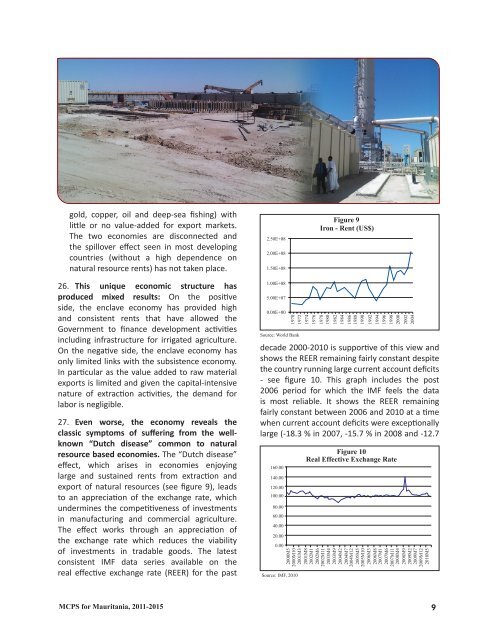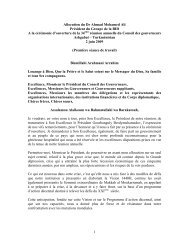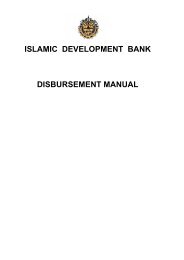Mauritania - Islamic Development Bank
Mauritania - Islamic Development Bank
Mauritania - Islamic Development Bank
Create successful ePaper yourself
Turn your PDF publications into a flip-book with our unique Google optimized e-Paper software.
gold, copper, oil and deep-sea fishing) with<br />
little or no value-added for export markets.<br />
The two economies are disconnected and<br />
the spillover effect seen in most developing<br />
countries (without a high dependence on<br />
natural resource rents) has not taken place.<br />
26. This unique economic structure has<br />
produced mixed results: On the positive<br />
side, the enclave economy has provided high<br />
and consistent rents that have allowed the<br />
Government to finance development activities<br />
including infrastructure for irrigated agriculture.<br />
On the negative side, the enclave economy has<br />
only limited links with the subsistence economy.<br />
In particular as the value added to raw material<br />
exports is limited and given the capital-intensive<br />
nature of extraction activities, the demand for<br />
labor is negligible.<br />
27. Even worse, the economy reveals the<br />
classic symptoms of suffering from the wellknown<br />
“Dutch disease” common to natural<br />
resource based economies. The “Dutch disease”<br />
effect, which arises in economies enjoying<br />
large and sustained rents from extraction and<br />
export of natural resources (see figure 9), leads<br />
to an appreciation of the exchange rate, which<br />
undermines the competitiveness of investments<br />
in manufacturing and commercial agriculture.<br />
The effect works through an appreciation of<br />
the exchange rate which reduces the viability<br />
of investments in tradable goods. The latest<br />
consistent IMF data series available on the<br />
real effective exchange rate (REER) for the past<br />
decade 2000-2010 is supportive of this view and<br />
shows the REER remaining fairly constant despite<br />
the country running large current account deficits<br />
- see figure 10. This graph includes the post<br />
2006 period for which the IMF feels the data<br />
is most reliable. It shows the REER remaining<br />
fairly constant between 2006 and 2010 at a time<br />
when current account deficits were exceptionally<br />
large (-18.3 % in 2007, -15.7 % in 2008 and -12.7<br />
MCPS for <strong>Mauritania</strong>, 2011-2015 9






